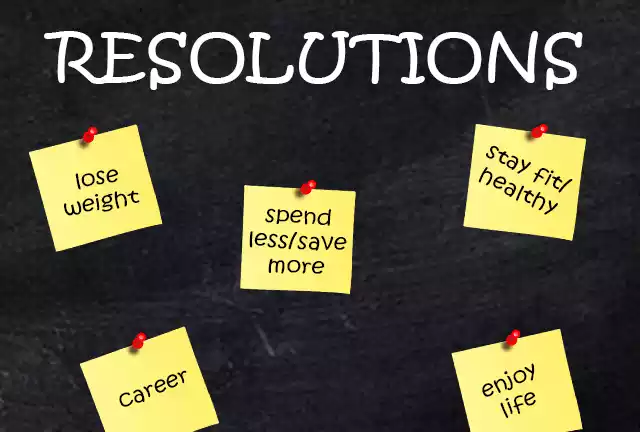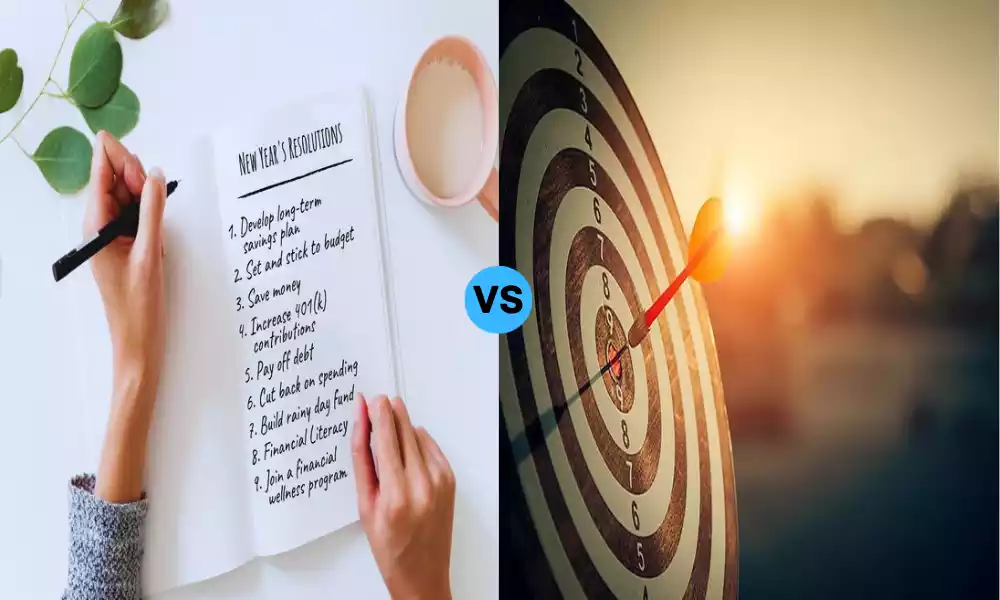Resolutions and goals are terms often used interchangeably, yet they carry distinct nuances that differentiate one from the other. Resolutions are broad commitments or promises made to oneself, frequently arising at the dawn of a new year or after a pivotal life event. They represent a desire to change, evolve, or improve in some aspect of life. Goals, on the other hand, are targeted outcomes accompanied by specific actions and milestones.
They are precise, measurable, and offer a clear roadmap to achieving desired results. While both aim to foster growth and improvement, understanding their unique characteristics can aid individuals in creating more effective and achievable plans for personal and professional development.
Definition of Resolutions
A resolution is a firm decision to do or not to do something. It represents a commitment or determination to change, adopt, or eliminate certain behaviors, habits, or patterns in one’s life. Often inspired by moments of reflection, resolutions are commonly associated with the beginning of a new year, where individuals aspire to make positive changes in their lives.

Unlike specific goals, resolutions are generally broader in scope and might lack clear, measurable criteria for achievement. They serve as overarching intentions or guiding principles rather than detailed action plans. For instance, “I resolve to lead a healthier lifestyle” or “I commit to being more environmentally conscious” are examples of resolutions.
Definition of Goals
A goal is a specific, clear, and measurable desired outcome or result that an individual or group aspires to achieve within a defined timeframe. Goals are accompanied by concrete actions, steps, or milestones that help in tracking progress and determining completion. They are often structured, giving individuals a clear direction and purpose. Using the SMART criteria (Specific, Measurable, Achievable, Relevant, Time-Bound) is a common approach to setting and defining goals.

An example of a goal could be, “I aim to lose 15 pounds by December” or “I intend to complete my novel by the end of the year.” Goals provide a roadmap, allowing for periodic assessment, accountability, and course correction as needed.
Comparison Table of Resolutions and Goals
Sure, here’s a comparison table of resolutions and goals:
| Feature | Resolutions | Goals |
|---|---|---|
| Definition | Broad intentions for personal growth. | Specific targets or outcomes to be achieved. |
| Time Frame | Typically long-term (e.g., yearly). | Can be short-term, mid-term, or long-term. |
| Specificity | More general (e.g., “Be healthier”). | Very specific (e.g., “Lose 10 pounds in 3 months”). |
| Accountability | Rely on annual revisits or self-reflection. | Often come with checkpoints or milestones. |
| Measurement | Harder to measure due to their general nature. | Easier to measure and track progress. |
| Setting | Commonly set during major events, like New Year’s. | Can be set anytime, anywhere. |
| Adaptability | Harder to modify since they are broad. | Can be easily adjusted based on progress or changing circumstances. |
| Emotional Attachment | Tied to personal values or overarching themes in life. | Often driven by specific needs or desires. |
| Success Rate | Can be challenging due to lack of specificity. | Higher success rate when well-defined and tracked. |
| Examples | “Be more mindful”, “Reduce stress”. | “Meditate for 15 minutes daily”, “Read one book per month”. |
Importance in Daily Life of Resolutions and Goals
Resolutions and goals play pivotal roles in guiding and enhancing our daily lives. Here’s a breakdown of their significance:
- Clarity and Direction
- Resolutions: Set the tone for a broader change, offering a guiding principle that can shape daily decisions and behaviors. For instance, a resolution to “live healthier” can influence your everyday choices, from taking the stairs to opting for a salad.
- Goals: Provide clear, tangible targets to work towards, ensuring that your daily actions align with a bigger purpose. A goal like “run 5km in under 30 minutes” can shape your daily exercise routine.
- Motivation and Drive
- Resolutions: Remind you of the broader changes and commitments you aspire to, helping maintain motivation for overarching life changes.
- Goals: Offer measurable milestones which, when achieved, can boost confidence and motivation. The joy of ticking off a completed goal can be a significant motivator for further achievement.
- Structure and Discipline
- Resolutions: Impose a general structure on life decisions, ensuring alignment with larger life values.
- Goals: Bring discipline to daily life by setting deadlines and actionable steps. They encourage a regimented approach, fostering habits like consistency and perseverance.
- Growth and Development
- Resolutions: Encourage introspection and self-awareness, pushing individuals to recognize areas of life that require improvement.
- Goals: Foster skills such as planning, time management, and strategic thinking. Achieving specific goals often requires skill development and learning.
- Accountability
- Resolutions: Act as a moral compass, holding individuals accountable to their desired life changes.
- Goals: Given their specificity, goals allow for easy tracking and self-assessment, holding individuals accountable to their progress and encouraging course correction when off track.
- Enhanced Well-being
- Resolutions: The journey of working towards and maintaining resolutions can lead to an improved sense of well-being and satisfaction, especially when they align with one’s values.
- Goals: The sense of accomplishment derived from achieving set goals can significantly boost mental health, offering a sense of purpose and achievement.
- Decision-making Framework
- Resolutions: When faced with daily decisions, your resolutions can act as a guiding framework, helping prioritize options that align with your larger intentions.
- Goals: Influence daily choices by presenting a clear outcome to work towards. When in doubt, decisions can be weighed against the goal’s progress.
While resolutions set the compass direction for life changes, goals are the roadmap with detailed paths and milestones. Both are crucial for personal and professional development, helping individuals lead purposeful and fulfilling lives.
The Psychology Behind Resolutions and Goals
Understanding the psychological foundations of resolutions and goals can shed light on why they work (or don’t) and how to harness them more effectively.

Let’s delve into the psychological aspects:
- Motivation Theory:
- Resolutions: These often stem from intrinsic motivations—inner desires for change or improvement, like wanting to be healthier or more mindful. Intrinsic motivations are usually more sustainable in the long run.
- Goals: They can be influenced by both intrinsic motivations (personal desires or interests) and extrinsic motivations (external rewards or recognitions). For instance, setting a goal to achieve a bonus at work is extrinsically motivated.
- Self-Determination Theory:
- This theory suggests that people are most motivated when they feel autonomous (acting with free will), competent (feeling effective in their actions), and related (connected to others).
- Resolutions can provide a sense of autonomy since they are personal commitments, while goals, when shared or collaborative, can satisfy the need for relatedness.
- Self-Efficacy:
- Coined by Albert Bandura, self-efficacy is the belief in one’s abilities to meet specific challenges or tasks.
- Clear, measurable goals can enhance self-efficacy because they provide concrete evidence of one’s capabilities when achieved.
- Resolutions, when maintained, can slowly build self-efficacy over time.
- Cognitive Dissonance Theory:
- This theory postulates that people have an inner drive to hold their beliefs and actions in harmony. When there is a mismatch, they feel discomfort.
- People who set resolutions or goals but don’t act on them may feel this discomfort, pushing them to either change their actions or modify their beliefs.
- Goal Setting Theory:
- According to Edwin Locke and Gary Latham, goals that are specific and challenging lead to higher performance. This is particularly true when individuals are committed to the goals and receive feedback on their progress.
- While resolutions are broader, translating them into specific goals can harness the power of this theory.
- Temporal Self-Regulation Theory:
- This considers the balance between immediate rewards and longer-term benefits.
- Resolutions often focus on long-term well-being, while goals can provide short-term rewards (like the satisfaction of meeting a weekly target), making them effective in the short and long run.
- Neurological Aspects:
- Achieving goals and maintaining resolutions can trigger the release of dopamine, the “feel-good” neurotransmitter, reinforcing the behavior that led to the achievement.
- However, the anticipation of a reward can also release dopamine, which may explain why some people get satisfaction from merely setting goals or resolutions, reducing their drive to follow through.
- Habit Formation:
- Both resolutions and goals can lead to habit formation. When actions aligning with resolutions or goals are consistently practiced, neural pathways strengthen, making the behavior more automatic over time.
The psychology behind resolutions and goals underscores their effectiveness and challenges. By understanding these principles, individuals can optimize their approach to setting and achieving both resolutions and goals.
Benefits of Achieving Resolutions and Goals
Achieving resolutions and goals not only offers tangible results but also brings about numerous psychological, emotional, and sometimes even physical benefits. Here’s a comprehensive breakdown:
- Enhanced Self-esteem and Confidence:
- Successfully meeting a target or sticking to a resolution boosts self-worth. This success reinforces the belief in one’s capabilities, leading to an overall increase in confidence.
- Sense of Accomplishment:
- Achieving a goal or maintaining a resolution provides a gratifying sense of achievement, which can serve as motivation for future endeavors.
- Improved Mental Health:
- Accomplishments, no matter how small, release dopamine, the “feel-good” neurotransmitter. This can improve mood, reduce anxiety, and boost overall mental well-being.
- Skill Development:
- Working towards a goal often requires the acquisition or refinement of certain skills. For instance, a goal to lead a team project may enhance leadership, communication, or organizational skills.
- Structural Change in Daily Routine:
- Resolutions, especially, can transform daily habits. For instance, a resolution to “be more active” might lead to consistent morning walks, restructuring one’s day beneficially.
- Better Time Management:
- Goals often come with deadlines. Working towards them helps in prioritizing tasks, optimizing schedules, and improving overall time management.
- Enhanced Focus and Determination:
- Having a clear goal in mind or a resolution to uphold can streamline focus, reducing distractions and increasing determination to push through challenges.
- Cultivation of Resilience:
- The journey to achieving goals or sticking to resolutions is often fraught with obstacles. Overcoming these cultivates resilience, teaching individuals to bounce back from setbacks.
- Physical Benefits (For Health-Related Goals):
- Goals like weight loss, increased physical activity, or healthier eating not only provide the satisfaction of achievement but also lead to tangible health benefits like reduced risk of chronic diseases, improved stamina, and better overall health.
- Financial Benefits (For Financial Goals):
- Achieving financial goals such as saving a certain amount, paying off debt, or investing wisely can lead to increased financial security and potentially, wealth accumulation.
- Clarity in Future Endeavors:
- Achieving a goal or realizing a resolution offers clarity. It helps individuals understand what works for them, guiding future decision-making and goal-setting processes.
- Improved Relationships:
- Personal goals or resolutions related to relationships, like “spend more quality time with family” or “be a better listener,” can lead to stronger, more fulfilling personal connections.
- Broadened Horizons:
- Some goals, especially those related to travel, learning, or experiences, can broaden horizons, offering new perspectives and insights about the world.
The benefits of achieving resolutions and goals span across various facets of life, from personal well-being and skill development to interpersonal relationships and worldly insights. They serve as testament to the power of purposeful intention and action.
How to Set Effective Resolutions and Goals
Setting effective resolutions and goals is crucial for ensuring they are achievable and impactful. Here are structured steps and guidelines for setting both:
Setting Effective Resolutions
- Self-Reflection:
- Begin by analyzing what truly matters to you. Think about areas in your life you’d like to improve or values you’d like to embody more deeply.
- Make It Meaningful:
- Resolutions should resonate with your core beliefs and desires. They’re more likely to stick if they’re rooted in personal significance rather than external pressures.
- Keep It Realistic:
- Choose resolutions that are feasible. For instance, instead of “I’ll never eat junk food again,” consider “I’ll make healthier food choices regularly.”
- Stay Broad but Not Vague:
- While resolutions should be overarching, they shouldn’t be too ambiguous. “I want to be happier” is vague; “I want to engage more in activities that make me happy” offers more direction.
- Write It Down:
- Putting your resolutions on paper or digitally can serve as a tangible reminder of your commitment.
- Share with Trusted Individuals:
- Discussing your resolutions with close friends or family can provide encouragement and a sense of accountability.
Setting Effective Goals
- Use the SMART Criteria:
- Specific: Clearly define what you want to accomplish.
- Measurable: Ensure you can track progress and know when the goal is achieved.
- Achievable: It should be challenging but within reach.
- Relevant: The goal should align with your broader objectives and values.
- Time-Bound: Set a clear deadline for completion.
- Break It Down:
- Chunk your goal into smaller milestones or tasks. This makes the journey manageable and allows for regular celebration of small victories.
- Prioritize:
- If you have multiple goals, determine their importance and urgency. This helps in allocating time and resources efficiently.
- Stay Flexible:
- Life is unpredictable. Be prepared to adjust your goals based on new information, changing circumstances, or unexpected obstacles.
- Visualize the Outcome:
- Regularly picturing the successful completion of your goal can be a powerful motivator.
- Commit Publicly:
- Just like with resolutions, sharing goals can increase accountability. But choose your audience wisely – naysayers can be demotivating.
- Review Regularly:
- Periodically assess your progress. If you’re veering off track, identify the reasons and recalibrate.
- Stay Persistent:
- Understand that setbacks are natural. What’s essential is the perseverance and determination to continue.
- Celebrate Achievements:
- When you reach your goal, take the time to celebrate. This not only offers a sense of fulfillment but also reinforces the positive behavior.
By understanding the differences between resolutions and goals and utilizing these steps, individuals can set intentions that are both inspiring and attainable, paving the way for personal and professional growth.
Final Thoughts
Resolutions and goals, while distinct in nature, serve as powerful tools for personal and professional development. Resolutions offer broad directives for life enhancement, rooted in introspection and overarching desires. Goals, on the other hand, provide specific, measurable targets that guide daily actions and behaviors. Together, they create a synergistic effect, with resolutions setting the compass direction and goals providing the detailed roadmap. Embracing both effectively can lead to a fulfilling journey of growth, accomplishment, and continuous evolution.



